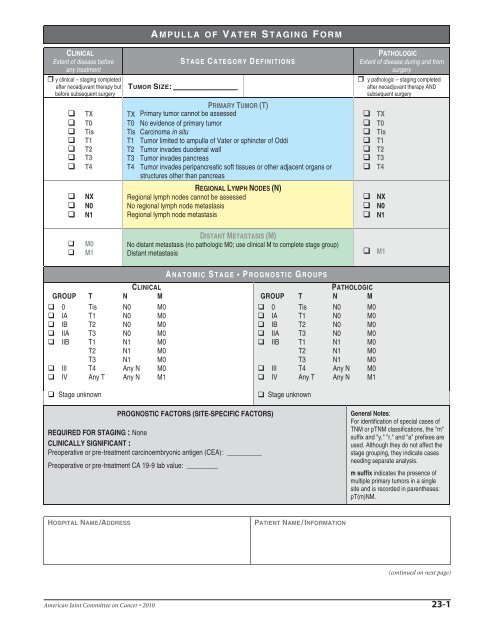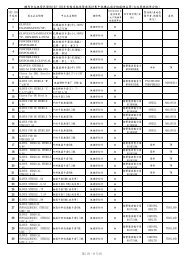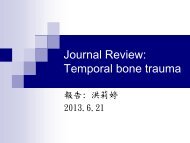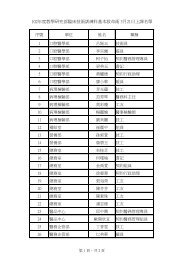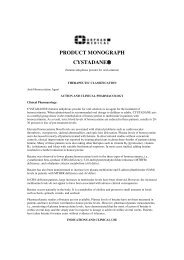AMPULLA OF VATER STAGING FORM - Sutter Medical Foundation
AMPULLA OF VATER STAGING FORM - Sutter Medical Foundation
AMPULLA OF VATER STAGING FORM - Sutter Medical Foundation
Create successful ePaper yourself
Turn your PDF publications into a flip-book with our unique Google optimized e-Paper software.
CLINICAL<br />
Extent of disease before<br />
any treatment<br />
y clinical – staging completed<br />
after neoadjuvant therapy but<br />
before subsequent surgery<br />
TX<br />
T0<br />
Tis<br />
T1<br />
T2<br />
T3<br />
T4<br />
NX<br />
N0<br />
N1<br />
M0<br />
M1<br />
TUMOR SIZE:<br />
CLINICAL<br />
GROUP T N M<br />
0 Tis N0 M0<br />
IA T1 N0 M0<br />
IB T2 N0 M0<br />
IIA T3 N0 M0<br />
IIB T1 N1 M0<br />
T2 N1 M0<br />
T3 N1 M0<br />
III T4 Any N M0<br />
IV Any T Any N M1<br />
A MPULLA <strong>OF</strong> <strong>VATER</strong> <strong>STAGING</strong> <strong>FORM</strong><br />
S TAGE C ATEGORY D EFINITIONS<br />
PRIMARY TUMOR (T)<br />
TX Primary tumor cannot be assessed<br />
T0 No evidence of primary tumor<br />
Tis Carcinoma in situ<br />
T1 Tumor limited to ampulla of Vater or sphincter of Oddi<br />
T2 Tumor invades duodenal wall<br />
T3 Tumor invades pancreas<br />
T4 Tumor invades peripancreatic soft tissues or other adjacent organs or<br />
structures other than pancreas<br />
REGIONAL LYMPH NODES (N)<br />
Regional lymph nodes cannot be assessed<br />
No regional lymph node metastasis<br />
Regional lymph node metastasis<br />
DISTANT METASTASIS (M)<br />
No distant metastasis (no pathologic M0; use clinical M to complete stage group)<br />
Distant metastasis<br />
A NATOMIC S TAGE P ROGNOSTIC G ROUPS<br />
Stage unknown Stage unknown<br />
PROGNOSTIC FACTORS (SITE-SPECIFIC FACTORS)<br />
REQUIRED FOR <strong>STAGING</strong> : None<br />
CLINICALLY SIGNIFICANT :<br />
Preoperative or pre-treatment carcinoembryonic antigen (CEA): __________<br />
Preoperative or pre-treatment CA 19-9 lab value: _________<br />
PATHOLOGIC<br />
GROUP T N M<br />
0 Tis N0 M0<br />
IA T1 N0 M0<br />
IB T2 N0 M0<br />
IIA T3 N0 M0<br />
IIB T1 N1 M0<br />
T2 N1 M0<br />
T3 N1 M0<br />
III T4 Any N M0<br />
IV Any T Any N M1<br />
HOSPITAL NAME/ADDRESS PATIENT NAME/IN<strong>FORM</strong>ATION<br />
PATHOLOGIC<br />
Extent of disease during and from<br />
surgery<br />
y pathologic – staging completed<br />
after neoadjuvant therapy AND<br />
subsequent surgery<br />
(continued on next page)<br />
American Joint Committee on Cancer 2010 23-1<br />
TX<br />
T0<br />
Tis<br />
T1<br />
T2<br />
T3<br />
T4<br />
NX<br />
N0<br />
N1<br />
M1<br />
General Notes:<br />
For identification of special cases of<br />
TNM or pTNM classifications, the "m"<br />
suffix and "y," "r," and "a" prefixes are<br />
used. Although they do not affect the<br />
stage grouping, they indicate cases<br />
needing separate analysis.<br />
m suffix indicates the presence of<br />
multiple primary tumors in a single<br />
site and is recorded in parentheses:<br />
pT(m)NM.
Histologic Grade (G) (also known as overall grade)<br />
Grading system<br />
2 grade system<br />
Grade<br />
Grade I or 1<br />
3 grade system Grade II or 2<br />
4 grade system Grade III or 3<br />
No 2, 3, or 4 grade system is available Grade IV or 4<br />
ADDITIONAL DESCRIPTORS<br />
Lymphatic Vessel Invasion (L) and Venous Invasion (V) have been combined into Lymph-Vascular<br />
Invasion (LVI) for collection by cancer registrars. The College of American Pathologists’ (CAP) Checklist<br />
should be used as the primary source. Other sources may be used in the absence of a Checklist. Priority is<br />
given to positive results.<br />
Lymph-Vascular Invasion Not Present (absent)/Not Identified<br />
Lymph-Vascular Invasion Present/Identified<br />
Not Applicable<br />
Unknown/Indeterminate<br />
Residual Tumor (R)<br />
The absence or presence of residual tumor after treatment. In some cases treated with surgery and/or with<br />
neoadjuvant therapy there will be residual tumor at the primary site after treatment because of incomplete<br />
resection or local and regional disease that extends beyond the limit of ability of resection.<br />
RX Presence of residual tumor cannot be assessed<br />
R0 No residual tumor<br />
R1 Microscopic residual tumor<br />
R2 Macroscopic residual tumor<br />
Clinical stage was used in treatment planning (describe):<br />
A MPULLA <strong>OF</strong> <strong>VATER</strong> <strong>STAGING</strong> <strong>FORM</strong><br />
National guidelines were used in treatment planning NCCN Other (describe):<br />
Physician signature Date/Time<br />
HOSPITAL NAME/ADDRESS PATIENT NAME/IN<strong>FORM</strong>ATION<br />
General Notes (continued):<br />
y prefix indicates those cases in<br />
which classification is performed<br />
during or following initial<br />
multimodality therapy. The cTNM<br />
or pTNM category is identified by a<br />
"y" prefix. The ycTNM or ypTNM<br />
categorizes the extent of tumor<br />
actually present at the time of that<br />
examination. The "y"<br />
categorization is not an estimate of<br />
tumor prior to multimodality<br />
therapy.<br />
r prefix indicates a recurrent tumor<br />
when staged after a disease-free<br />
interval, and is identified by the "r"<br />
prefix: rTNM.<br />
a prefix designates the stage<br />
determined at autopsy: aTNM.<br />
surgical margins is data field<br />
recorded by registrars describing<br />
the surgical margins of the<br />
resected primary site specimen as<br />
determined only by the pathology<br />
report.<br />
neoadjuvant treatment is<br />
radiation therapy or systemic<br />
therapy (consisting of<br />
chemotherapy, hormone therapy,<br />
or immunotherapy) administered<br />
prior to a definitive surgical<br />
procedure. If the surgical<br />
procedure is not performed, the<br />
administered therapy no longer<br />
meets the definition of neoadjuvant<br />
therapy.<br />
(continued from previous page)<br />
23-2 American Joint Committee on Cancer 2010


